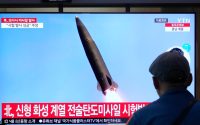She’s 98, and Walked Past Corpses to Escape Russian Attacks
When a Russian soldier appeared outside 98-year-old Lidiia Lomikovska’s shattered home in eastern Ukraine in late April, the first thing he did was shoot and kill the family dog.
“What have you done?” her daughter-in-law, Olha, 66, shouted at the Russian. “He was protecting me.”
“Now, I will protect you,” he told her, Olha recalled in an interview.
Ms. Lomikovska — who lived through a famine orchestrated by Stalin that killed millions in the 1930s and the German occupation of her town, Ocheretyne, during World War II — said she did not know why her life has been bracketed by sorrow.
But when war once again arrived at her doorstep, she knew she did not want to live under the “protection” of Russia.
As shells exploded around the town, she became separated from her family in the chaos. So she set off on foot alone. For hours, wearing a pair of slippers and without food or water, she walked past the bodies of dead soldiers, stumbling over bomb craters, unsure if her next step would be her last.
“I was walking the whole way and there was nobody anywhere, just gunshots, and I was wondering if they were shooting at me,” she said in an interview. “I walked, crossed myself, and thought, if only this war would end, if only everything would stop.”
But the war is not ending, and Russia’s relentless assaults in the Donetsk region are threatening to expose half a million civilians living in areas under Ukrainian control to even more intense bombardments.
At the same time, Russian forces recently pushed new lines of attack in the northeast, outside Kharkiv, and Ukrainian officials are warning that Moscow may seek to open another front in the north by crossing over the border toward the city of Sumy. More than 20,000 people have been evacuated from the Sumy and Kharkiv regions in recent weeks, Ukrainian officials reported at the end of May.
The Russian advances have been slow and bloody. With each step forward, another town, village or settlement is invariably left in ruins.
“It’s terrible, it’s like hell, when you come to a settlement where everything is burning nearby, where these guided air bombs have completely destroyed houses, multistory buildings, private houses,” said Pavlo Diachenko, 40. He is a police officer with the White Angels, a group dedicated to evacuating civilians from the areas facing the greatest risk.
Last month, the group was racing to help 10 to 20 people every day in the Donetsk region.
“People don’t even have the opportunity to take anything with them — they only take one bag with their belongings or a small purse,” he said.
At the moment, the Russians are mostly laying siege to relatively small villages and towns, many already largely empty.
But as the front line shifts, hundreds of thousands of civilians in towns and cities still under Ukrainian control in the Donbas region are watching nervously.
In February, Ukrainian officials said that during the course of the war at least 1,852 civilians had been killed in the Donetsk region, part of the Donbas, with another 4,550 injured.
By May 10, that toll had risen to 1,955 killed and 4,885 injured, local authorities said.
Those numbers are likely to vastly understate the full death toll, according to Ukrainian officials, human rights investigators and United Nations observers. There is still no internationally recognized accounting of the civilians killed in areas under Russian occupation.
For Mr. Diachenko, persuading people to evacuate is often a challenge, and sometimes ends tragically.
“When you come and talk to people about the need for evacuation, and the next day, unfortunately, you come to take them away and they are already dead from shelling,” Mr. Diachenko said. “This is probably the most painful thing for each of us.”
Over the months in which the front line remained relatively static, many people who fled near the beginning of the full-scale war returned in the belief that the risks were manageable and outweighed by a deep attachment to their homes.
The most dangerous place in Ukraine is the zone that falls within range of the artillery and drones of both armies. It extends roughly 20 miles in either direction from the front line, with the violence increasing exponentially closer to the point of contact between the two armies.
The earth is cratered like some tortured moonscape, corpses go uncollected for months amid constant shelling, and the prospect of death hovers in the skies above, where drones stalk all those who move. Mortars, mines, missiles, bombs explode day and night.
Even small shifts in the front open new villages to destruction.
Serhii Bahrii, the head of the village of Bohorodychne in the Donetsk region, knows well what happens when the fighting reaches a new town.
“In 2022, a bomb hit my house, and we miraculously survived in the basement,” he said. “It was terrifying. Everything was burning. Everything was red. I remember there was no oxygen. I tried to breathe it in, but there was none.”
In Bohorodychne, he said, only 29 of the 700 residents have come back.
There is no electricity or running water. Miles of dragons’ teeth, pyramid-shaped concrete spikes meant to ensnare tanks, stretch over the rolling hills beyond the battered homes. The people there survive largely by relying on small, carefully tended gardens and on volunteers bringing food, water and medicine as well as a sanitary trailer donated by an American Mormon to shower and wash clothes.
Still, Mr. Bahrii said, people were hopeful that the delivery of American weapons would prevent the arrival of the Russians in the area a second time.
“Hope,” he said, “but not certainty.”
Many of those who fled did not go far, choosing to stay in the nearby cities of the Donbas to be close to their land. If the Russians were to manage major advances, he said, those new homes in those cites would come under threat.
“It is unlikely that anyone will stay,” he said. “These people already know what bombings, explosions and death are like.”
Ms. Lomikovska, the 98-year-old, had not wanted to leave. Even as fighting intensified around her home, she tried to keep tending to her garden — planting potatoes, onions, garlic and herbs.
Born in 1926 — a few years before famine ravaged the land — she knew what it was like to be without food. No matter the dangers around her, her family said, her plot of fertile soil was a lifeline she tended with care.
“In my childhood, times were very hard and there was nothing to eat,” Ms. Lomikovska said. “We survived on what we grew in the garden.”
By the time the Germans occupied her village in 1941, she was a teenager.
“I wasn’t afraid then,” she said. Even though German soldiers slept in the family home, she said, “they didn’t touch anything.”
She and her husband raised two sons in the home they built in Ocheretyne, and she spent long periods working on the railways as a cabin conductor, tending to passengers. Her husband and her youngest son died before the current war once again upended her world.
She recalled the horror of the final sleepless nights before the Russians seized her town in April.
“I didn’t lie down lengthwise on the bed, but crosswise,” she said. “I pulled my legs toward me. My bed was by the window, and there was nothing left on the window at all. If we barricade the window with something, they’ll just break it. And the wind was strong. It was very cold. I lie there and hear gunshots.”
She is now staying with her granddaughter in a small house about a dozen miles from Chasiv Yar, a hilltop town that is being razed to the ground as Russian forces try to capture it.
If the Russians manage to take Chasiv Yar — which currently prevents Russia from laying siege to the major population centers in the Donetsk region — Ms. Lomikovska knows she might have to flee once again.
“And now,” she said, ‘I don’t know where else I’ll go.”


